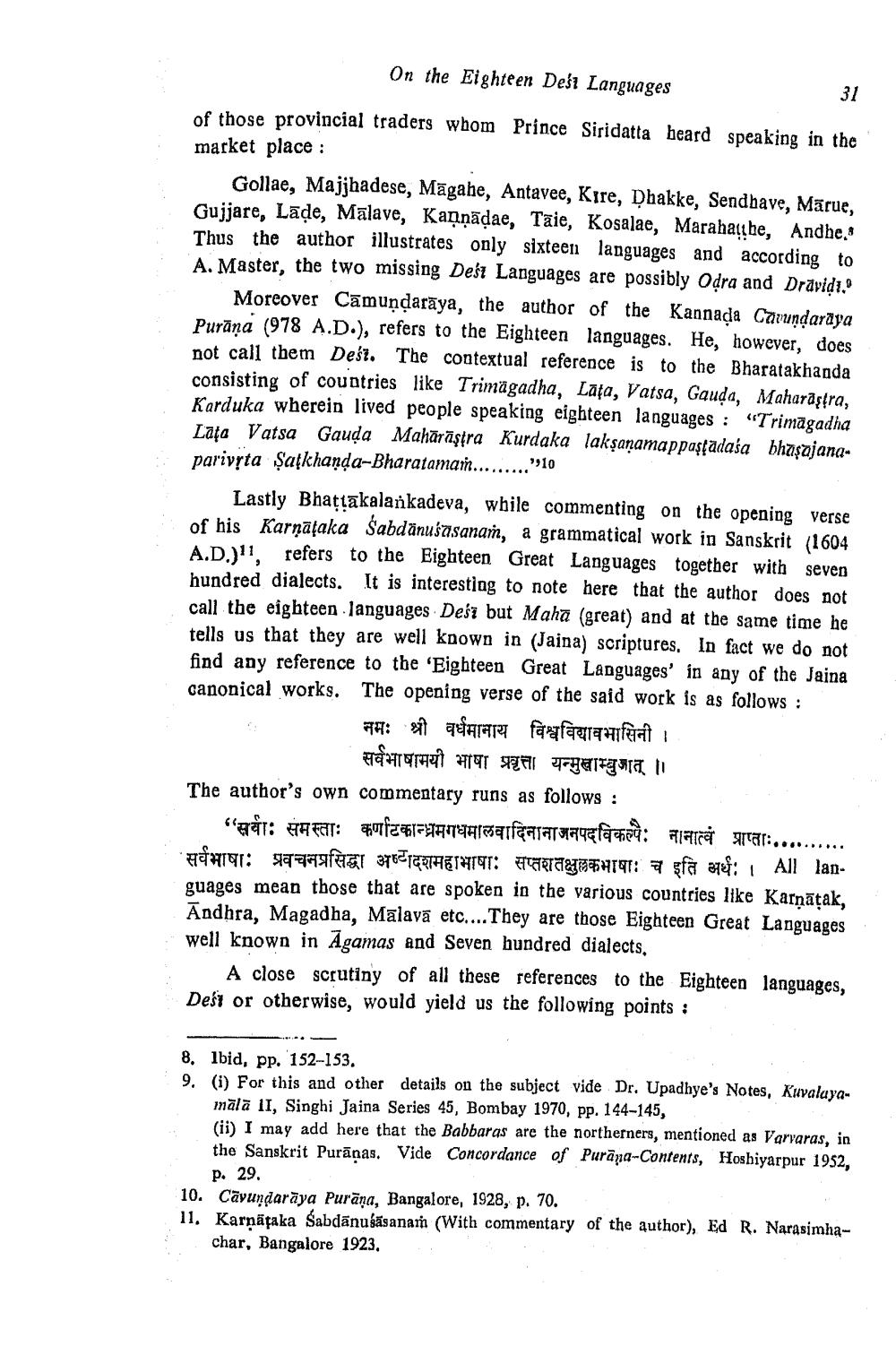________________
On the Eighteen Debi Languages
of those provincial traders whom Prince Siridatta heard speaking in the market place :
Gollae, Majjhadese, Māgahe, Antavee, Kure, Dhakke, Sendhave, Mārue, Gujjare, Lāde, Mālave, Kannadae, Taie, Kosalae, Marahabe, Andhe. Thus the author illustrates only sixteen languages and according to A. Master, the two missing Deśt Languages are possibly Odra and Dravidi."
Moreover Cāmuṇdarāya, the author of the Kannada Carundaraya Purāna (978 A.D.), refers to the Eighteen languages. He, however, does not call them Dest. The contextual reference is to the Bharatakhanda consisting of countries like Trimägadha, Lafa, Vatsa, Gauda, Maharastra, Karduka wherein lived people speaking eighteen languages: "Trimāgadha Lata Vatsa Gauda Mahārāştra Kurdaka lakşanamappastadaśa bhaşajanaparivịta Şatkhanda-Bharatamam........."10
Lastly Bhattakalankadeva, while commenting on the opening verse of his Karņāțaka Šabdānuśasanan, a grammatical work in Sanskrit (1604 A.D.)11 refers to the Eighteen Great Languages together with seven hundred dialects. It is interesting to note here that the author does not call the eighteen languages Desz but Maha (great) and at the same time he tells us that they are well known in (Jaina) scriptures. In fact we do not find any reference to the 'Eighteen Great Languages' in any of the Jaina canonical works. The opening verse of the said work is as follows:
नमः श्री वर्धमानाय विश्वविद्यावभासिनी ।
सर्वभाषामयी भाषा प्रवृत्ता यन्मुखाम्बुजात् ।। The author's own commentary runs as follows :
"सवाः समस्ताः कर्णाटकान्ध्रमगधमालवादिनानाजनपदविकल्पैः नानात्वं प्राप्ताः.... : $#fhEn SPEEDGRAETHAT: R E#HI9T: sfa atef: 1 All languages mean those that are spoken in the various countries like Karnātak, Āndhra, Magadha, Malavä etc.... They are those Eighteen Great Languages well known in Agamas and Seven hundred dialects.
A close scrutiny of all these references to the Eighteen languages. Dest or otherwise, would yield us the following points :
8. lbid, pp. 152-153. 9. (i) For this and other details on the subject vide Dr. Upadhye's Notes, Kuvalaya
mälā II, Singhi Jaina Series 45, Bombay 1970, pp. 144-145, (ii) I may add here that the Babbaras are the northerners, mentioned as Varvaras, in the Sanskrit Purānas. Vide Concordance of Purāņa-Contents, Hoshiyarpur 1952,
p. 29. 10. Cāyundarāya Purāna, Bangalore, 1928, p. 70. 11. Karnataka Sabdānusāsanan (With commentary of the author), Ed R. Narasimha
char, Bangalore 1923,




